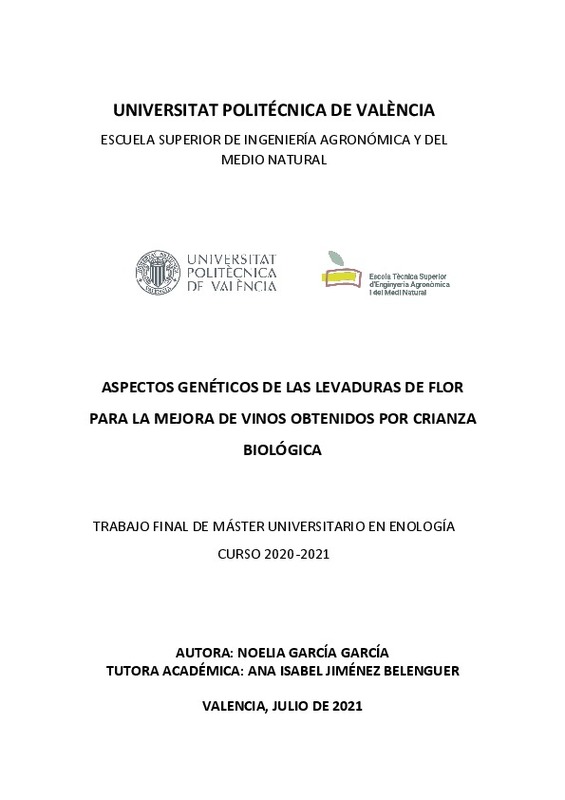|
Resumen:
|
[ES] Los vinos de Jerez amparados por las Denominaciones de Origen "Jerez-Xérès-Sherry" y "Manzanilla - Sanlúcar de Barrameda" son productos de una gran calidad que cuentan con un elevado reconocimiento en el mundo de la ...[+]
[ES] Los vinos de Jerez amparados por las Denominaciones de Origen "Jerez-Xérès-Sherry" y "Manzanilla - Sanlúcar de Barrameda" son productos de una gran calidad que cuentan con un elevado reconocimiento en el mundo de la enología. Este tipo de vinos se caracteriza por tener una crianza biológica llevada a cabo por ciertas cepas de Saccharomyces cerevisiae, conocidas como levaduras de flor. Este tipo de crianza es muy particular y ocurre tras la fermentación alcohólica, en la cual se forma el denominado velo de flor, un biofilm que aporta a estos vinos una serie de características organolépticas muy interesantes y que les hace ser únicos en el mundo. Las levaduras de flor tienen una genética muy particular y está poco estudiada. Por ello resulta muy interesante profundizar en dicho campo y se ha realizado una búsqueda bibliográfica. Se ha buscado información acerca de las levaduras de flor y sus características genéticas que hacen diferencial a este tipo de vinificación en bases de datos como Pubmed y Google Scholar. En dichas bases de datos se han encontrado trabajos que han caracterizado los genes que están involucrados en procesos exclusivos de dicha vinificación, como pueden ser los genes FLO11, NRG1, HSP12, BTN2 y diversas técnicas de mejora genética, como puede ser por ejemplo la hibridación de cepas o la mutagénesis inducida. Además, se ha visto que existen diversas sustancias y factores que favorecen el envejecimiento biológico de los vinos de Jerez, como puede ser el polen de abeja o la lisozima. Pese a que el volumen de producción y consumo de estos vinos es bastante alto se constata que hay poca bibliografía al respecto y hay distintos aspectos metabólicos en dicha crianza en los cuales todavía se desconoce su relación con los aspectos genéticos que la regulan.
[-]
[EN] Sherry wines protected by the "Jerez-Xérès-Sherry" and "Manzanilla - Sanlúcar de Barrameda" Appellations of Origin are high quality products that are very important in the world of oenology. This type of wine is ...[+]
[EN] Sherry wines protected by the "Jerez-Xérès-Sherry" and "Manzanilla - Sanlúcar de Barrameda" Appellations of Origin are high quality products that are very important in the world of oenology. This type of wine is characterized by having a biological aging carried out by certain strains of Saccharomyces cerevisiae, known as flower yeasts (Flor yeast). This type of aging is very particular and occurs after alcoholic fermentation, in which the flower veil is formed, a biofilm that gives these wines a series of very interesting organoleptic characteristics that makes them unique in the world. Flor yeasts have very particular genetics, and it is little studied. For this reason, it is very interesting to go deeper in this field and a bibliographic search has been carried out. Information about flower yeasts and their genetic characteristics that make this type of wine making differentiates have been sought in databases such as Pubmed and Google Scholar. In these databases there have been found research about which genes are involved in those exclusive processes of winemaking. Those genes have been characterized, such as the genes FLO11, NRG1, HSP12, BTN2. Also, various genetic improvement techniques, such as, for example, the hybridization of strains or the induced mutagenesis. In addition, it has been seen that there are various substances and factors that favor the biological aging of Sherry wines, such as bee pollen or lysozyme. Even though the volume of production and consumption of these wines is quite high, it is found that there is little bibliography on the matter and there are different metabolic aspects in those aging in which their relationship with the genetic aspects that regulate it is still unknown.
[-]
|







